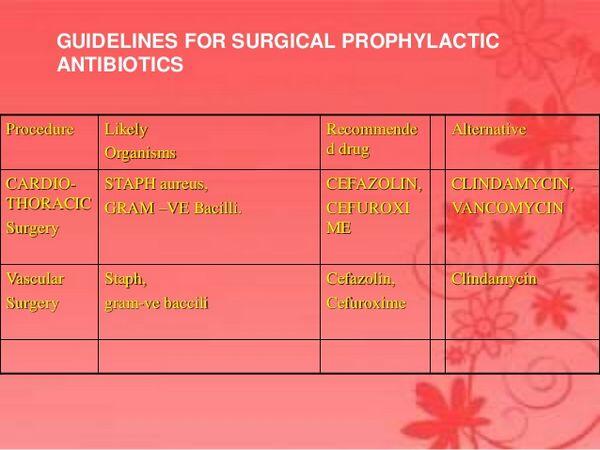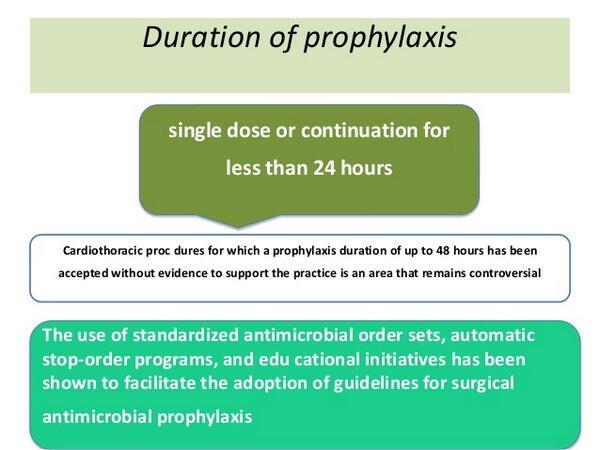Definition
- Antibiotics administered prior to contamination of previously uninfected tissues or fluids are considered prophylactic. The goal for prophylactic antibiotics is to prevent a surgical-site infection from developing. The prevention and management of non-surgical-site infection postoperative infections, such as catheter-related urinary tract infections, occasionally require antibiotics, but prevention of non-surgical-site infection infections is not the goal of surgical prophylaxis.
- Presumptive antibiotic therapy is administered when an infection is suspected but not yet proven. Therapeutic antibiotics are required for established infection.
- surgical-site infections are classified as either incisional (such as cellulites of the incision site) or involving an organ or space (such as with meningitis). Incisional surgical-site infections may be superficial (skin or subcutaneous tissue) or deep (fascial and muscle layers). Both types, by definition, occur by postoperative day 30. This period extends to 1 year in the case of deep infection associated with prosthesis implantation.
Risk factors for surgical wound infection
The traditional classification system developed by the National Research Council stratifying surgical procedures by infection risk is reproduced in Table NRC Wound Classification, Risk of SSI, and Indication for Antibiotics. The National Research Council wound classification for a specific procedure is determined intraoperatively.
Individualizing risk for surgical wound infection
- The Study on the Efficacy of Nosocomial Infection Control analyzed more than 100,000 surgery cases and identified abdominal operations, operations lasting more than 2 hours, contaminated or dirty procedures, and more than three underlying medical diagnoses as factors associated with an increased incidence of surgical-site infection. When the National Research Council classification described in Table NRC Wound Classification, Risk of SSI, and Indication for Antibiotics was stratified by the number of Study on the Efficacy of Nosocomial Infection Control risk factors present, the infection rates varied by as much as a factor of 15 within the same operative category.
- The Study on the Efficacy of Nosocomial Infection Control risk assessment technique has been modified to include the American Society of Anesthesiologists preoperative assessment score (Table American Society of Anesthesiologists Physical Status Classification). An American Society of Anesthesiologists score of 3 or above was associated with increased surgical-site infection risk.
Microbiology
- Bacteria involved in surgical-site infection are either acquired from the patient’s normal flora (endogenous) or from contamination during the surgical procedure (exogenous).
- Loss of protective flora via antibiotics can upset the balance and allow pathogenic bacteria to proliferate and increase infectious risk.
- Normal flora can become pathogenic when translocated to a normally sterile tissue site or fluid during surgical procedures.
- According to the National Nosocomial Infections Surveillance System (NNIS), the five most common pathogens encountered in surgical wounds are Staphylococcus aureus, coagulase-negative staphylococci, enterococci, Escherichia coli, and Pseudomonas aeruginosa.
| TABLE. NRCa Wound Classification, Risk of SSIb, and Indication for Antibiotics | |||||||||||||||||||||||||||||||||||||
|
|||||||||||||||||||||||||||||||||||||
| TABLE. American Society of Anesthesiologists Physical Status Classification | |||||||||||||||||||||||||||||||||||||
|
|||||||||||||||||||||||||||||||||||||
- Impaired host defenses, vascular occlusive states, traumatized tissues, or presence of a foreign body greatly decrease the number of bacteria required to cause a surgical-site infection.
Antibiotic issues
Scheduling antibiotic administration
The following principles must be considered when providing antimicrobial surgical prophylaxis.
- Antimicrobials should be delivered to the targeted tissue site prior to the initial incision. They should be administered with anesthesia, just prior to initial incision.
- Bactericidal antibiotic tissue concentrations should be maintained throughout the surgical procedure.
Strategies to ensure appropriate antimicrobial prophylaxis use are described in Table Strategies for Implementing an Institutional Program to Ensure the Appropriate Use of Antimicrobial Prophylaxis in Surgery.
Antimicrobial selection
- The choice of the prophylactic antimicrobial depends on the type of surgical procedure, most likely pathogenic organisms, safety and efficacy of the antimicrobial, track record for success based on published literature, and costs.
| TABLE. Strategies for Implementing an Institutional Program to Ensure the Appropriate Use of Antimicrobial Prophylaxis in Surgery | |
|
- Typically, gram-positive coverage is included in the choice of surgical prophylaxis, because organisms such as S. aureus and Staphylococcus epidermidis are common skin flora.
- Parenteral antibiotic administration is favored because of its reliability in achieving suitable tissue concentrations.
- First-generation cephalosporins (particularly cefazolin) are the preferred choice, particularly for clean surgical procedures.
- Vancomycin may be considered for prophylactic therapy in surgical procedures involving implantation of a prosthetic device in which the rate of methicillin resistant staphylococcus aureus is high.
- If the risk of methicillin resistant staphylococcus aureus is low and a β- lactam hypersensitivity exists, clindamycin can be used instead of cefazolin in order to limit vancomycin use.
- In cases where broader gram-negative and anaerobic coverage is desired, the antianaerobic cephalosporins such as cefoxitin, or cefotetan, are appropriate.
Recommendations for specific types of surgery
Specific recommendations are summarized in Table Most Likely Pathogens and Specific Recommendations for Surgical Prophylaxis.
Gastroduodenal surgery
- The risk of infection rises with conditions that increase gastric pH and subsequent bacterial overgrowth, such as obstruction, hemorrhage, malignancy, or acid-suppression therapy (clean-contaminated).
- A single dose of intravenous (intravenous) cefazolin will provide adequate prophylaxis for most cases.
- Postoperative therapeutic antibiotics may be indicated if perforation is detected during surgery, depending on whether an established infection is present.

Biliary tract surgery
- Antibiotic prophylaxis has been proven beneficial for surgery involving the biliary tract.
- Most frequently encountered organisms include E. coli, Klebsiella, and enterococci. Single-dose prophylaxis with cefazolin is currently recommended.
- For low-risk patients undergoing elective laparoscopic cholecystectomy, antibiotic prophylaxis is of no benefit and is not recommended.
- Antibiotic prophylaxis is not currently recommended prior to endoscopic retrograde cholangiopancreatography.
- Some surgeons use presumptive antibiotics for cases of acute cholecystitis or cholangitis and defer surgery until the patient is afebrile, in an attempt to decrease infection rates further, but this practice is controversial.
- Detection of an active infection during surgery (gangrenous gallbladder, suppurative cholangitis) is an indication for therapeutic postoperative antibio- tics.
Colorectal surgery
- Anaerobes and gram-negative aerobes predominate in surgical-site infections, although gram-positive aerobes are also important. Therefore, the risk of surgical-site infection in the absence of an adequate prophylactic regimen is substantial.
- Reducing bacteria load with a thorough bowel preparation regimen (4 L of polyethylene glycol solution administered orally the day before surgery) is controversial, even though it is used by most surgeons.
| TABLE. Most Likely Pathogens and Specific Recommendations for Surgical Prophylaxis | ||||||||||||||||||||||||||||||||||||||||||||||||||||||||||||||||||||||||
|
||||||||||||||||||||||||||||||||||||||||||||||||||||||||||||||||||||||||
- The combination of 1 g of neomycin and 1 g of erythromycin base given orally 19, 18, and 9 hours preoperatively is the most commonly used oral regimen in the United States.
- Whether perioperative parenteral antibiotics, in addition to the standard preoperative oral antibiotic regimen, will lower surgical-site infection rates further is controversial.
- Postoperative antibiotics are unnecessary in the absence of any untoward events or findings during surgery.
Appendectomy
- A cephalosporin with antianaerobic activity such as cefoxitin or cefotetan is currently recommended as a first-line agent. Cefotetan may be superior for longer operations because of its longer duration of action.
- Single-dose therapy with cefotetan is adequate. Intraoperative dosing of cefoxitin may be required if the procedure extends beyond 3 hours.
- Established intra-abdominal infections require appropriate therapeutic postoperative antibiotics.
Urologic procedures
- As long as the urine is sterile preoperatively, the risk of surgical-site infection after urologic procedures is low and the benefit of prophylactic antibiotics in this setting is controversial. E. coli is the most frequently encountered organism.
- Antibiotic prophylaxis is warranted in high-risk patients (e.g., prolonged indwelling catheterization, positive urine cultures, and neutropenia) undergoing transurethral, perineal, or suprapubic resection of the prostate, resection of bladder tumors, or cystoscopy.
- Urologic procedures requiring an abdominal approach such as a nephrectomy or cystectomy require prophylaxis appropriate for a clean-contaminated abdominal procedure.

Cesarean section
- Antibiotics are efficacious to prevent surgical-site infections for women undergoing cesarean section regardless of underlying risk factors.
- Cefazolin, 2 g intravenous, remains the drug of choice. Providing a broader spectrum by using cefoxitin against anaerobes or piperacillin for better coverage against Pseudomonas or enterococci, for example, does not lower postoperative infection rates any further in comparative studies.
- Antibiotics should be administered just after the umbilical cord is clamped, avoiding exposure of the infant to the drug.
Hysterectomy
- Vaginal hysterectomies are associated with a high rate of postoperative infection when performed without the benefit of prophylactic antibiotics.
- Cefazolin is the drug of choice. Single-dose therapy should be adequate, but most reports used a 24-hour regimen.
- Abdominal hysterectomy surgical-site infection rates are correspondingly lower than vaginal hysterectomy rates. However, prophylactic antibiotics are still recommended regardless of underlying risk factors.
- Both cefazolin and antianaerobic cephalosporins (e.g., cefoxitin, cefotetan) have been studied extensively. Single-dose cefotetan is superior to single-dose cefazolin.
- The antibiotic course should not exceed 24 hours in duration.
Head and neck surgery
- Use of prophylactic antibiotics during head and neck surgery depends on the procedure type. Clean procedures, such as parotidectomy or a simple tooth extraction, are associated with low rates of surgical-site infection.
- Head and neck procedures involving an incision through a mucosal layer carry a high risk of surgical-site infection.
- While typical doses of cefazolin are ineffective for anaerobic infections, the recommended 2-g dose produces concentrations high enough to be inhibitory to these organisms. A 24-hour duration has been used in most studies, but single-dose therapy may also be effective.
- For most head and neck cancer sections, 24 hours of clindamycin is appropriate.
Cardiac surgery
- Although most cardiac surgeries are technically clean procedures, prophylactic antibiotics have been shown to lower rates of surgical-site infection.
- The usual pathogens are skin flora (see Table Most Likely Pathogens and Specific Recommendations for Surgical Prophylaxis) and, rarely, gram-negative enteric organisms.
- Risk factors for developing an surgical-site infection after cardiac surgery include obesity, renal insufficiency, connective tissue disease, reexploration for bleeding, and poorly timed administration of antibiotics.
- Cefazolin has been extensively studied and is currently considered the drug of choice. Patients weighing 80 kg should receive 2 g cefazolin rather than 1 g. Doses should be administered no earlier than 60 minutes before the first incision and no later than the beginning of induction of anesthesia.
- Extending antibiotic administration beyond 48 hours does not lower surgical-site infection rates. Single-dose cefazolin therapy may be sufficient.
- It may be necessary to use vancomycin in hospitals with a high incidence of surgical-site infection with methicillin resistant staphylococcus aureus or when sternal wounds are to be explored for possible mediastinitis.
Noncardiac vascular surgery
- Prophylactic antibiotics are beneficial, especially in procedures involving the abdominal aorta and the lower extremities.
- Twenty-four hours of prophylaxis with intravenous cefazolin is adequate. For patients with β- lactam allergy, 24 hours of oral ciprofloxacin is effective.
Orthopedic surgery
- Prophylactic antibiotics are beneficial in cases involving implantation of prosthetic material (pins, plates, artificial joints).
- The most likely pathogens mirror those of other clean procedures and include staphylococci and, infrequently, gram-negative aerobes.
- Cefazolin is the best-studied antibiotic and is thus the drug of choice. For hip fracture repairs and joint replacements, it should be administered for 24 hours.
Neurosurgery
- The use of prophylactic antibiotics in neurosurgery is controversial.
- Single doses of cefazolin or, where required, vancomycin appear to lower surgical-site infection risk after craniotomy.
Minimally invasive and laparoscopic surgery
The role of prophylactic antimicrobials depends on the type of procedure performed and preexisting risk factors for infection. There are insufficient clinical trials to provide general recommendations.

